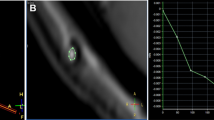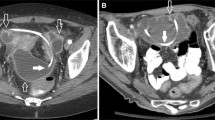Abstract
Background
Successful shunt access is the first step in a properly performed nuclear medicine cerebrospinal fluid (CSF) shunt study.
Objective
To determine the significance of the radiotracer configuration at the injection site during initial nuclear medicine CSF shunt imaging and the lack of early systemic radiotracer activity as predictors of successful shunt access.
Materials and methods
With Institutional Review Board approval, three nuclear medicine physicians performed a retrospective review of all consecutive CSF shunt studies performed in children at our institution in 2015. Antecedent nuclear medicine CSF shunt studies in these patients were also assessed and included in the review. The appearance of the reservoir site immediately after radiotracer injection was classified as either figure-of-eight or round/ovoid configuration. The presence or absence of early systemic distribution of the tracer on the 5-min static images was noted and separately evaluated.
Results
A total of 98 nuclear medicine ventriculoperitoneal CSF shunt studies were evaluated. Figure-of-eight configuration was identified in 87% of studies and, when present, had 93% sensitivity, 78% specificity, 92% accuracy, 98% positive predictive value (PPV) and 54% negative predictive value (NPV) as a predictor of successful shunt access. Early systemic activity was absent in 89 of 98 studies. Lack of early systemic distribution of the radiotracer had 98% sensitivity, 78% specificity, 96% accuracy, 98% PPV and 78% NPV as a predictor of successful shunt access. Figure-of-eight configuration in conjunction with the absence of early systemic tracer activity had 99% PPV for successful shunt access.
Conclusion
Figure-of-eight configuration at the injection site or lack of early systemic radiotracer activity had moderate specificity for successful shunt access. Specificity and PPV significantly improved when both signs were combined in assessment.






Similar content being viewed by others
References
Hegde A, Nair RP, Ganapathy S et al (2016) Shunt malfunction in patients with hydrocephalus: complications revisited. BMJ Case Rep 2016. https://doi.org/10.1136/bcr-2015-213619
Riva-Cambrin J, Kestle JR, Holubkov R et al (2016) Risk factors for shunt malfunction in pediatric hydrocephalus: a multicenter prospective cohort study. J Neurosurg Pediatr 17:382–390
Boyle TP, Nigrovic LE (2015) Radiographic evaluation of pediatric cerebrospinal fluid shunt malfunction in the emergency setting. Pediatr Emerg Care 31:435–440
Maller VV, Agarwal A, Kanekar S (2016) Imaging of ventricular shunts. Semin Ultrasound CT MR 37:159–173
Wallace AN, McConathy J, Menias CO et al (2014) Imaging evaluation of CSF shunts. AJR Am J Roentgenol 202:38–53
Sivaganesan A, Krishnamurthy R, Sahni D et al (2012) Neuroimaging of ventriculoperitoneal shunt complications in children. Pediatr Radiol 42:1029–1046
May CH, Aurisch R, Kornrumpf D et al (1999) Evaluation of shunt function in hydrocephalic patients with the radionuclide 99mTc-pertechnetate. Childs Nerv Syst 15:239–244
Vassilyadi M, Tataryn ZL, Matzinger MA et al (2006) Radioisotope shuntograms at the Children's Hospital of Eastern Ontario. Childs Nerv Syst 22:43–49
Thompson EM, Wagner K, Kronfeld K et al (2014) Using a 2-variable method in radionuclide shuntography to predict shunt patency. J Neurosurg 121:1504–1507
Treves ST, SpringerLink (Online service) (2007) Pediatric Nuclear Medicine/PET. Springer Science+Business Media, LLC, New York, NY
Vernet O, Farmer JP, Lambert R et al (1996) Radionuclide shuntogram: adjunct to manage hydrocephalic patients. J Nucl Med 37:406–410
Key CB, Rothrock SG, Falk JL (1995) Cerebrospinal fluid shunt complications: an emergency medicine perspective. Pediatr Emerg Care 11:265–273
Rocque BG, Lapsiwala S, Iskandar BJ (2008) Ventricular shunt tap as a predictor of proximal shunt malfunction in children: a prospective study. J Neurosurg Pediatr 1:439–443
Vega RA, Buscher MG, Gonzalez MS et al (2013) Sonographic localization of a nonpalpable shunt: Ultrasound-assisted ventricular shunt tap. Surg Neurol Int 4:101
Rickham PP (1964) A ventriculostomy reservoir. Br Med J 2:173
Scott RM (1991) Shunt malfunction and the Rickham reservoir. Neurosurgery 28:167
Weiser HC, Gilbert JW (1990) Needle size for puncture of a Rickham reservoir. Surg Neurol 33:230
Schlosser HG, Crawack HJ, Miethke C et al (2016) An improved reservoir for the flushing test to diagnose shunt insufficiency. Neurosurg Focus 41:E14
MacDonald A, Burrell S (2009) Infrequently performed studies in nuclear medicine: part 2. J Nucl Med Technol 37:1–13
Lehnert BE, Rahbar H, Relyea-Chew A et al (2011) Detection of ventricular shunt malfunction in the ED: relative utility of radiography, CT, and nuclear imaging. Emerg Radiol 18:299–305
O'Brien DF, Taylor M, Park TS et al (2003) A critical analysis of 'normal' radionucleotide shuntograms in patients subsequently requiring surgery. Childs Nerv Syst 19:337–341
Ouellette D, Lynch T, Bruder E et al (2009) Additive value of nuclear medicine shuntograms to computed tomography for suspected cerebrospinal fluid shunt obstruction in the pediatric emergency department. Pediatr Emerg Care 25:827–830
Chiewvit S, Nuntaaree S, Kanchaanapiboon P, Chiewvit P (2014) Assessment lumboperitoneal or ventriculoperitoneal shunt patency by radionuclide technique: a review experience cases. World J Nucl Med 13:75–84
Chervu S, Chervu LR, Vallabhajosyula B et al (1984) Quantitative evaluation of cerebrospinal fluid shunt flow. J Nucl Med 25:91–95
Wynchank S, Brendel AJ, Castel JP et al (1984) Re: Quantitative evaluation of cerebrospinal fluid shunt flow. J Nucl Med 25:1269–1270
Brendel AJ, Wynchank S, Castel JP et al (1983) Cerebrospinal shunt flow in adults: radionuclide quantitation with emphasis on patient position. Radiology 149:815–818
Lawrance SK (2003) Cerebrospinal fluid imaging. In: Sandler MP (ed) Diagnostic nuclear medicine, 4th edn. Lippincott Williams & Wilkins, Philadelphia, PA
Di Rocco C, Turgut M, Jallo GI Martinez-Lage J (2015) Complications of CSF shunting in hydrocephalus prevention, identification, and management. Springer, Heidelberg
Gok B, Batra S, Eslamy H et al (2013) Radionuclide shunt patency study for suspected ventriculoatrial shunt malfunction. Clin Nucl Med 38:527–533
Author information
Authors and Affiliations
Corresponding author
Ethics declarations
Conflicts of interest
None
Rights and permissions
About this article
Cite this article
Bermo, M.S., Khalatbari, H. & Parisi, M.T. Two signs indicative of successful access in nuclear medicine cerebrospinal fluid diversionary shunt studies. Pediatr Radiol 48, 1130–1138 (2018). https://doi.org/10.1007/s00247-018-4150-8
Received:
Revised:
Accepted:
Published:
Issue Date:
DOI: https://doi.org/10.1007/s00247-018-4150-8




